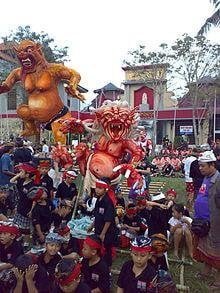Nyepi is a Hindu celebration mainly celebrated in Bali, Indonesia. It is a day of silence, fasting and meditation for the Balinese. The day following Nyepi is celebrated as Hindu New Year’s Day. The same day celebrated in India as Ugadi. Nyepi is commemorated every Isakawarsa (Saka new year) according to the Balinese calendar (in 2018, it fell on March 17).
The Hindus of Maharashtra term the same festival, observed on the same day, Gudi Padwa (Marathi: गुढी पाडवा). The Sindhis, people from Sindh, celebrate the same day as Cheti Chand, which is the beginning of their calendar year. Manipuris also celebrate their New Year as Sajibu Nongma Panba on the same day. The Hindus of Andhra Pradesh also celebrate their new year on the same day as Ugadi.
The Melasti Ritual is performed 3–4 days beforehand Nyepi. It is dedicated to Sanghyang Widhi Wasa. The ritual is performed in Pura (Balinese temple) near the sea (Pura Segara) and meant to purify Arca, Pratima, and Pralingga (sacred objects) belonging to several temples, also to acquire sacred water from the sea. The Bhuta Yajna Ritual is performed next to vanquish the negative elements and create a balance with God, Mankind, and Nature. The ritual is also meant to appease Batara Kala by Pecaruanoffering of live animal sacrifice. Around sunset the “Pengrupukan” ceremony begins in the house compounds with the noisy banging of pots and pans and bamboo tubes along with burning of dried coconut leaf torches to drive out the demons.
The Bhuta Yajna Ritual is performed next to vanquish the negative elements and create a balance with God, Mankind, and Nature. The ritual is also meant to appease Batara Kala by Pecaruanoffering of live animal sacrifice. Around sunset the “Pengrupukan” ceremony begins in the house compounds with the noisy banging of pots and pans and bamboo tubes along with burning of dried coconut leaf torches to drive out the demons.
Most Hindu Balinese villages make ogoh-ogoh, demonic statues made of richly painted bamboo, cloth, tinsel, and styrofoam symbolizing negative elements or malevolent spirits or even characters from Hindu mythology. After the ogoh-ogoh have been paraded around the village, they are burned in the cemeteries although many are displayed in front of community halls for another month or more and sometimes even purchased by museums and collectors.
Nyepi is a day reserved for self-reflection, and as such, anything that might interfere with that purpose is restricted. The main restrictions are no lighting fires (and lights must be kept low); no working; no entertainment or pleasure; no traveling; and, for some, no talking or eating at all. The effect of these prohibitions is that Bali’s usually bustling streets and roads are empty, there is little or no noise from TVs and radios, and few signs of activity are seen even inside homes. The only people to be seen outdoors are the Pecalang, traditional security men who patrol the streets to ensure the prohibitions are being followed.
In 2018, a parade of 7,000 exhibits including a joint Narsimha sanhaar was paraded on the streets.
The Nyepi Rituals are performed as Amati Geni: No fire or light, including no electricity, Amati Karya: No working, Amati Lelunganan: No travelling and Amati Lelanguan: Fasting and no revelry/self-entertainment. The Yoga/Brata Ritual starts at 6:00 a.m. and continues to 6:00 a.m. the next day. The Ngembak Agni/Labuh Brata Ritual is performed for all Hindus to forgive each other and to welcome the new days to come. Finally, The Dharma Shanti Rituals is performed after all the Nyepi rituals are finished.
The day following Nyepi is also celebrated as New Year’s Day. On this day, the youth of Bali in the village of Sesetan in South Bali practice the ceremony of Omed-omedan or ‘The Kissing Ritual’ to celebrate the new year.
On the day after Nyepi, known as Ngembak Geni (Relighting the Fire), social activity picks up again quickly, as families and friends gather to ask forgiveness from one another, and to perform certain religious rituals together. Fires and electricity are allowed again, and cooking of food resumes.
(Source Wikipedia)

